Growing Apple Trees
Here's a look at apple tree pollination, planting and protecting your trees
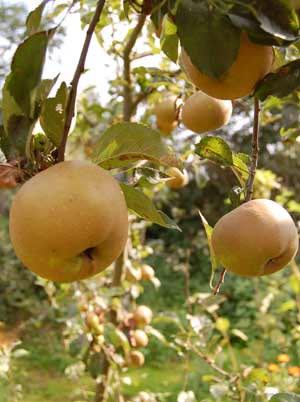
Growing apple trees is easy but when buying, you do need to consider pollination needs before you select your trees!
This page also deals with planting apple trees for a good start in your garden and protecting your new trees from rabbits, deer and wind.
This is the second page on growing apples. Other pages that might interest you:
Growing apples (1): The different shapes and sizes and what to choose for your site.
Growing apples (3) How to prune apple trees and disease prevention and management.
Apple tree pollination groups
The next important thing to consider before growing apple trees is the blossom groups or pollination groups.
Apple trees need to have another apple tree nearby flowering at the same time so that pollination can occur. If you live near to other people with apple trees this might solve the problem for you.
If you live where there are no nearby suitable apples or crab apples then you will need to buy young trees which are compatible. For example, if you buy one Egremont Russet, then you will need either a second Russet or a different variety which is compatible. Otherwise, a long-flowering crab apple can do the trick as they are compatible with many apple varieties.
One of the fun things about growing apple trees at home is exploring the less usual varieties.
Suffolk, where I live, has lots of venerable old apple varieties which are well worth growing. Organisations are springing up to preserve and propagate old varieties like these.
It's also great to grow your own organic apples because you are promoting your own good health, that of your family and the long-term health of the soil.
If you consider this route to apple heaven, do take advice so that your apple trees are pollinated properly each season. Growing apple trees successfully is even more satisfying if you raise organic well-adapted stock.
Growing apple trees -
About the pollination groups
Things can get complicated here. Apple trees are divided by growers into pollination groups. Commonly they are divided into 4 or 5 main groups but there are more complicated systems which are favoured by some growers.
The main reason for these groups is because flowering occurs at different times. If you buy a group 1 pollinator and pair it up with a group 5 pollinator you are unlikely to get any fruit from either. The bees which do the work are unable to time travel!
There is some cross-over between adjacent groups and a flowering crab apple can be very useful because they often have a long flowering period.
But failing that, you do need to select new trees for growing apples quite carefully.
If you want to research some of the less common varieties and their pollination groups check out: Garden Action which has a good list of pollination groups.
More on pollination - triploid pollinators
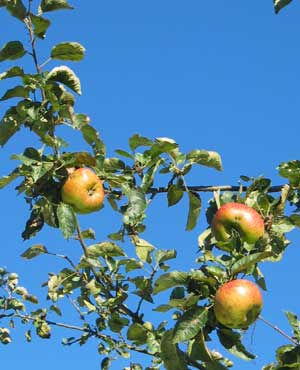
What makes apple tree pollination sound even more complicated is that there are some trees which require two different nearby apple trees to ensure successful pollination. They are called triploid pollinators. The common cooking apple Bramley and Blenheim Orange both come into this group.
In practice, it's usually quite easy to ensure good pollination occurs. Just get several compatible trees and place them near each other.
It's also worth checking what trees your neighbours have; this can save you the need buy a tree just for pollination purposes. Neighbours' trees need to be within a short distance from your orchard (20 or 30 metres or less, ideally) and the tree(s) need to be compatible.
Sponsored links
Growing apple trees -
How old is my new tree - and how long will it live?
When you buy stock for growing apple trees you can buy them almost ready to crop at a few years old. If you plant them carefully and look after them you should have usable fruit within two to three years. If this looks like an expensive option you can buy one year old apple trees called "maidens" more cheaply.
The downside of this is that you won't be actually harvesting apples to eat for a few more years. If you are prepared to wait five or more years for your crops this can be a cheaper option, worth considering if you are looking to extend an already productive orchard, perhaps.
It's also worth knowing that most of the small-rootstock trees sold in garden centres have a relatively limited lifespan. Growing apple trees on standard rootstocks - which become relatively big trees - is a good idea if you have space. Many of these trees can live for a hundred years or more.
Many of the smaller garden apple trees grown on small rootstocks may only manage ten to twenty years as productive trees. However, they are quicker to reach fruit-bearing maturity.
Having selected some suitable apple trees you next need to think about planting your tree.
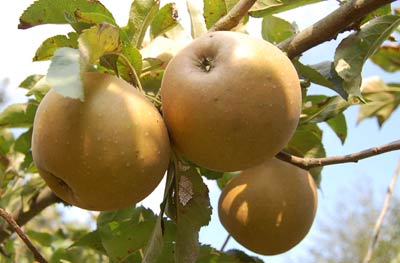
Picture: Growing apple trees to provide dessert apples for your table is very rewarding. Egremont Russet is a sweet and tasty variety. This one is on a semi-dwarf rootstock.
Growing apple trees -
Planting your trees
Buy your trees in late autumn, winter or early spring. The soil should be damp but not freezing cold. Late October on is a good time in the northern hemisphere. If you plant at other times be very careful to irrigate thoroughly and keep a look out for the new plants drying out. You can sometimes find cheap trees at the end of the season in garden centres and nurseries.
Its generally not worth buying bare-rooted trees outside of the proper planting times. The risk of failure is too high. Pot-grown apple trees are a bit more forgiving but adequate irrigation is absolutely essential.
Space and light
It is important that your trees have enough space to grow and thrive and that there is plenty of available light. Other than that, planting is easy. Avoid any dubious areas, for example where old concrete has been buried. If you plant in grass you need to clear back the turf in a ring around the tree and keep it clear. Your young tree is far more likely to die in its first year if it is throttled with grass.
Dig a hole double the width of the pot that the young apple tree has grown in. Make it slightly deeper than the pot. Loosen the soil in the bottom of the hole and add a shovel full of good compost. Mix the compost into the soil.
Carefully remove the pot from the roots (you may need to turn the whole thing upside down and deliver a sharp tap with the back of a spade.) Loosen any stray root ends so that contact with the soil from the hole is made straight away.
Staking the tree
Place the apple tree into the hole and add a stake which is at least 4 feet tall. Don't let the stake interfere with the roots. Backfill the soil and a little more compost.
Check that the new soil level around the plant does not cover the join where the tree was grafted. This is usually quite low down near the base of the plant. You do want the top of the potting compost from the plant pot to be covered because peat (the usual medium) does dry out rather quickly. Your new tree will retain moisture better if the top is covered with soil. Make sure that you tread everything down carefully so that the root ball is stable in the earth and in good contact with the soil.
Water everything copiously. The tree should be tied below where the leaves start to the post so as to stabilise it if the wind picks up. Some growers put the stake in at an angle so as to avoid the root ball. Old tights are an excellent choice for tying up young trees. They don't have to be recognisable - just cut off a leg! They are flexible yet strong and durable.
You can buy proper tree ties which keep the space between the tree and the stake without any rubbing or undue movement. They are not particularly expensive and can be re-used.
Tree ties should not keep the tree immobile but should rather reduce wind movement to a manageable amount. Trees which are staked too rigidly may not develop their own root system to cope with wind, leaving them potentially vulnerable.
Sponsored links
Growing apple trees -
Protecting young apple trees from rabbits (Grr!)
Protecting young apple trees from roving wildlife and from strong winds is essential. If you have rabbits or other wildlife such as deer in the area you will need to use a tree guard. Even rabbits can be amazingly destructive to young growing apple trees. They can kill them in one night's action!
I know because this is what happened to me. I thought my garden was rabbit-free but some got in and nibbled right around one tree and nearly destroyed a second one. I'd only just bought them! It set the less damaged tree back about two years and the other one was dead within a few days. Expensive mistake.
You will need more than a spiral plastic tree-guard if deer or other large ruminants are near your trees. Erect a wire fence at a distance which makes it impossible to reach the tree. Make sure the fencing posts are stout and well anchored in the ground.
Deer and rabbit netting is now available from Amazon.
If you have a secure border to your orchard, growing apple trees can be more straight forward. But you will still need to anchor your new trees with stakes because it can hard for the root ball to become established if there is a lot of wind buffeting.
Wind protection for apple trees
Some native species hedges around your orchard can help keep the wind down. It is no accident that many traditional orchards are found within high walls or in other secluded locations.
Tree-based wind wind protection has the advantage that the wind speed is calmed rather than completely altered. High walls can create turbulence which affects some areas behind the wall. Trees and hedges reduce strong winds for crops sheltering on the lee side.
Even with good shelter, some kind of staking is almost essential for the first few months of growth while the tree gets properly established.
***
Apple growing books
If you want good books about growing apple trees and related topics here are a few choices to whet your appetite.
Apples to Oregon: Being the (Slightly) True Narrative of How a Brave Pioneer Father Brought Apples, Peaches, Pears, Plums, Grapes, and Cherries (and Children) ... the Plains (Golden Kite Awards (Awards)) is a fabulous choice for getting children interested in the heritage of apple trees and other fruits.
The Apple Grower: Guide for the Organic Orchardist
This guy knows his onions - or rather his apples! He's been growing them and promoting organic orchards and fruit growing in the US for years!
See more book selections from Amazon on the right side panel. I haven't read them all - but they look good! It's well worth having one or two good books to consult on apple growing; you can explore issues in more depth than you will find on most web pages.
Orchard apples are a delight well worth having. I hope you have some great success growing apple trees at home.
Don't forget that in many places it is now becoming easier to set up a community orchard. See Fruit tree orchards and the community for more on this.
*****
Return from Growing Apple Trees back to Green Orchards - Growing Fruit Trees
Greenfootsteps Home - for more easy green living ideas
| Tweet |

| Tweet |

On other pages:
The Nutritional Value of Fruit
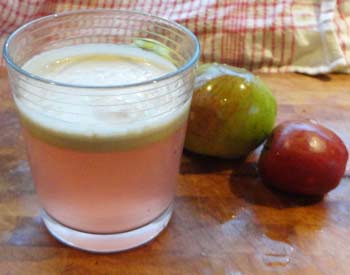
Sponsored links
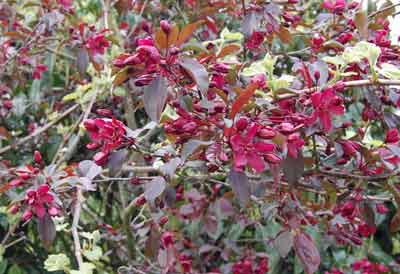
Picture: Red crabapple flowers
Footprints
- an occasional e-zine from Greenfootsteps
If you would like to receive the e-zine, please just sign up below.






New! Comments
Have your say about what you just read! Leave me a comment in the box below.